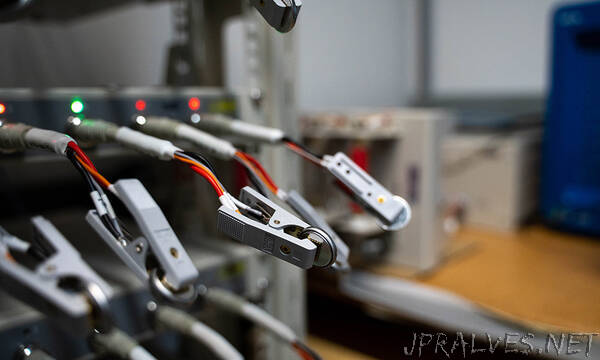
“UBCO’s collaboration with Fenix Advanced Materials kicks into high-gear
UBC Okanagan researchers have teamed up with a BC company to create a smaller, more powerful battery than what’s currently available.
The collaboration with Fenix Advanced Materials of Trail, BC, is helping researchers in UBCO’s Advanced Materials for Energy Storage Lab design and develop much improved state-of-the-art batteries. The latest published research is part of a $2-million initiative between Fenix, Mitacs and UBC Okanagan. The research investment strengthens Canada’s position in emerging solid-state battery innovation and accelerates electric vehicle (EV) deployment and renewable energy opportunities, says Dr. Jian Liu, an Assistant Professor in the School of Engineering.
“Advancements in solid-state batteries are propelling the EV industry forward along with the added benefit of advancing emerging devices in medicine and communications,” explains Dr. Liu. “All-solid-state, lithium-tellurium batteries enable higher energy output with an improved safety rating inside a smaller form-factor, thereby expanding its possible applications.”
In order for a battery to work, it needs to store chemical energy and convert it into electrical energy. The process involves an electrochemical reaction that transfers electrons from one electrode to the other through an external circuit, while ions move inside the battery. While rechargeable lithium-ion batteries are the most popular on the market, Dr. Liu and his research team are confident they can make one that is smaller and more powerful than current existing battery technologies.
The key ingredient for this research is tellurium, a by-product of copper, iron and other base-metal-rich ore bodies. It has attracted the attention of researchers because it has high electrical conductivity and a high volumetric capacity. The collaboration with Fenix will ensure Dr. Liu and his team have the materials to conduct their research.
“Fenix is very excited and fully committed to this collaboration by committing $1-million over the five-year project. We will also contribute many of the critical high purity metal by-products, like the tellurium and indium needed for this research,” says Don Freschi, Fenix Advanced Materials CEO. “The ultimate goal will be to commercialize these new batteries and continue collaborating with UBCO on many new clean technologies.”
It’s not just about making a better battery, it’s also about helping the planet, says Dr. Liu. Transportation accounts for 25 per cent of greenhouse gases emissions in Canada. The adoption of EVs along with improved batteries could have a profound impact on reducing those emissions.
“The added benefit of using tellurium is that manufacturers are reusing a mining waste product,” says Dr. Liu. “The BC Interior has a wealth of these raw materials which bodes well for developing and manufacturing of next-generation lithium-tellurium batteries within a circular economy.”
The latest test battery includes a flexible gel polymer electrolyte that allows lithium ions to move between lithium anode and tellurium cathode. This results in a quasi-solid-state lithium-tellurium battery that has improved performance compared to lithium-sulphur and lithium-selenium batteries.
“The high purity of the tellurium along with the mineral’s overall attributes makes it ideal as a rechargeable battery material,” says Dr. Liu.
Dr. Liu holds a Principal’s Research Chair in Energy Storage Technology at UBC Okanagan where he leads the Advanced Materials for Energy Storage Lab. He and his research team continue to fine-tune the lithium-tellurium battery configuration to fully develop safe and high-performance solid-state lithium-tellurium batteries.
The latest research was published in the Journal of Colloid and Interface Science. It was supported by the Mitacs Accelerate Program, Natural Sciences and Engineering Research Council of Canada, Canada Foundation for Innovation, BC Knowledge Development Fund and Fenix Advanced Materials.”
